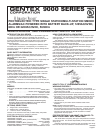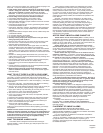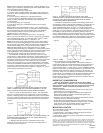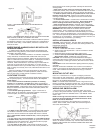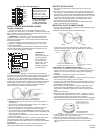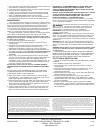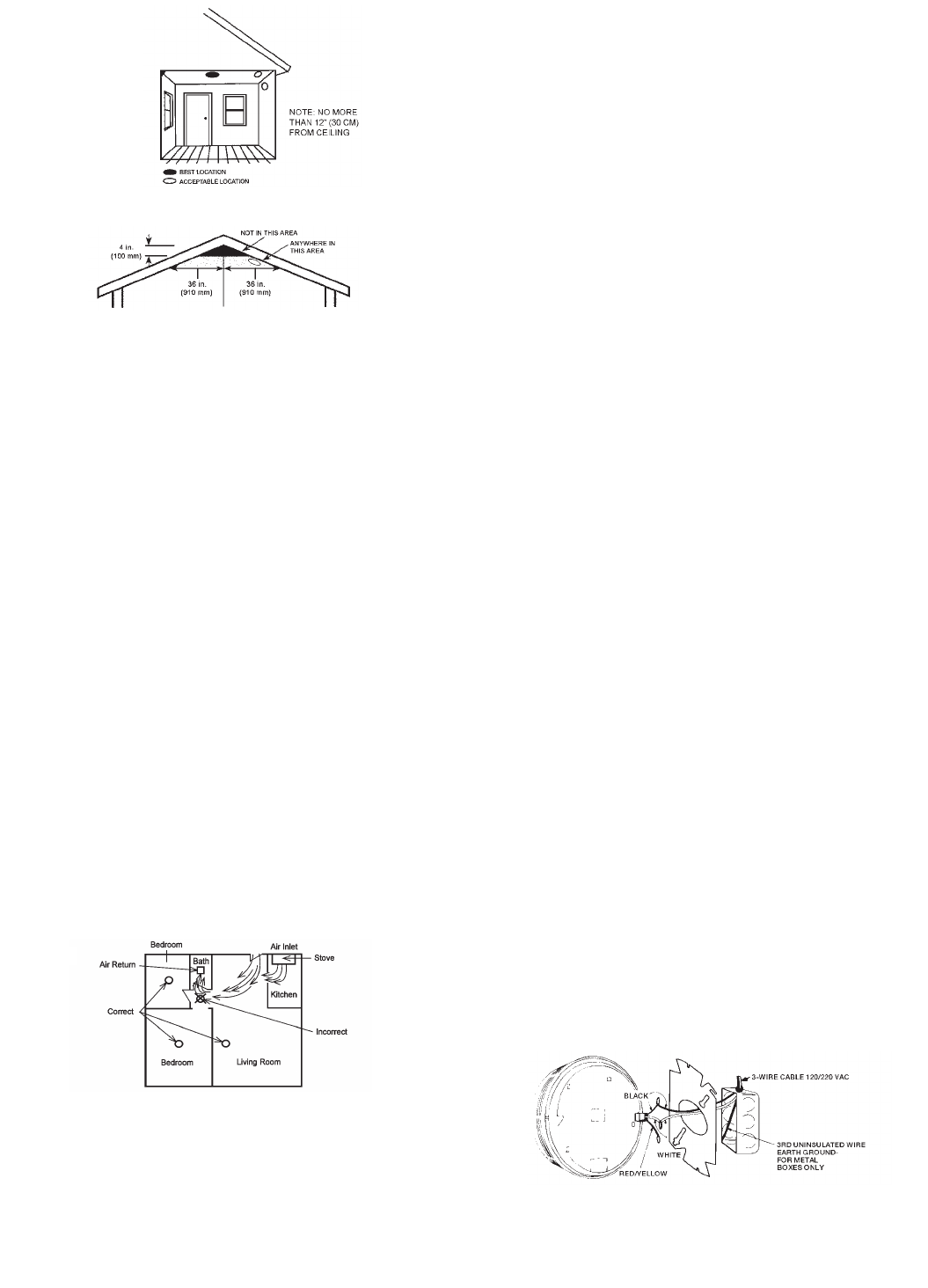
Figure 6: RECOMMENDED SMOKE ALARM LOCATION IN ROOMS
WITH SLOPED, GABLED, OR PEAKED CEILINGS.
The placement of the smoke alarm is critical if maximum speed of
fire detection is desired. Thus, a logical location for a smoke alarm is
the center of the ceiling. At this location, the device is closest to all
areas of the room.
WHERE SMOKE ALARMS SHOULD BE INSTALLED
IN MOBILE HOMES
In mobile homes built after about 1978 that were designed and
insulated to be energy-efficient, smoke alarms should be installed as
described in the section above.
In older mobile homes that have little or no insulation compared to
today's standards, uninsulated metal outside walls and roofs can
transfer heat and cold from outdoors, making the air right next to them
hotter or colder than the rest of the inside air. These layers of hotter or
colder air can prevent smoke from reaching a smoke alarm.
Therefore, install smoke alarms in such units only on inside walls not
more than 12 inches (30 cm) from the ceiling. If you are not sure
about the insulation level in your mobile home, or if you notice that the
walls or ceiling are unusually hot or cold, install the smoke alarm on an
inside wall.
Minimum protection requires one smoke alarm as close to the
sleeping area as possible. For better protection, install one smoke
alarm in each room, but first read the "Locations to Avoid."
LOCATIONS TO AVOID
Nuisance alarms are caused by placing smoke alarms where they
will not operate properly. To avoid nuisance alarms, do not place
smoke alarms:
In or near areas where combustion particles are normally
present such as kitchens; in garages where there are particles of
combustion in vehicle exhausts; near furnaces, hot water heaters, or
gas space heaters. Install smoke alarms at least 20 feet (6 meters)
away from kitchens and other areas where combustion particles are
normally present.
In air streams passing by kitchens. Figure 7 shows how a
smoke alarm can be exposed to combustion particles in normal air
movement paths, and how to correct this situation.
Figure 7
block openings to the sensing chamber and keep the device from
sensing smoke.
Near fresh air inlets, returns or excessively drafty areas. Air
conditioners, heaters, fans, and fresh air intakes and returns can drive
smoke away from smoke alarms, making the devices less effective.
In dead air spaces at the top of a peaked roof or in the corners
between ceilings and walls. Dead air may prevent smoke from
reaching a smoke alarm. See Figures 5 and 6 for recommended
mounting locations.
In insect-infested areas. If insects enter a smoke alarm's sensing
chamber, they may cause a nuisance alarm. Get rid of the bugs
before installing smoke alarms where bugs are a problem.
Near fluorescent light fixtures. Electrical "noise" from nearby
fluorescent light fixtures may cause a nuisance alarm. Install smoke
alarms and fluorescent lights on separate electrical circuits.
WARNING! Never disconnect an AC smoke alarm to silence a
nuisance alarm. Open a window or fan the air around the unit to
remove the smoke. The smoke alarm will automatically turn off when
the smoke in the air is completely gone. Do not stand close to the
unit. The sound produced by the device is loud because it is designed
to awaken you in an emergency. Prolonged exposure to the horn at a
close distance may be harmful to your hearing.
INSTALLATION 9000 SERIES
CAUTION: New Construction: DO NOT attach smoke alarm head
until AFTER sanding, painting, and other dust creating situations are
finished and cleaned up.
WIRING/GENERAL
1. Use U.L. Listed cable with Class 1 insulation.
2. Observe local code requirements. Use box connector to anchor
cable to outlet box.
3. Metal outlet boxes must be grounded to earth ground.
4. NOTICE: Use only Duracell MN 1604 battery with the 9000
Series smoke alarms. Available at many retail stores.
CAUTION: Turn off electricity to prevent SHOCK and damage to
smoke alarm. Be sure the power line to the unit is not controlled by
any on/off switch, or other type of switch, other than a fuse or circuit
breaker.
IMPORTANT: Insure that all fluorescent lighting fixtures are properly
grounded.
NOTICE: Smoke alarm installation must conform to the electrical
codes in your area and to Article 760 of the U.S. National Electrical
Code. Wire installation should be performed only by a licensed
electrician.
MOUNTING OUTLET BOX
Use a 2" x 3" switch box or a 4" square or octagon junction box.
Mount a box for each smoke alarm. If wall mounting is desired, be
sure the box screws are oriented to upper right and lower left corners.
Be sure to use supplied Mounting Plate.
NOTE: For trouble areas where there can be a large volume of air
blowing out through the electrical junction box. You must first insert
the cardboard shield packaged with your smoke alarm to the backside
of device before securing it to the mounting plate.
WIRING ONE SMOKE ALARM
1. Run a minimum of 16 gauge, 2-conductor cable, plus ground
(3 wires) to the junction box from a power supply. Smoke alarms shall
be connected to their own dedicated circuit. Use ANSI/UL Listed
Class 1 wire.
NOTE: The wiring to be used shall be in accordance with the
provisions of Article 300.3(b) of the National Electrical Code,
NFPA 70, as well as Article 210.
2. Make wire connections to the supplied plug-in connector as
follows: black to black, white to white, and connect the ground
wire to the metal outlet box.
Figure 6
Figure 5: RECOMMENDED SMOKE ALARM MOUNTING
LOCATIONS
Figure 5
In damp or very humid areas, or next to bathrooms with showers.
The moisture in humid air can enter the sensing chamber as water
vapor, then cool and condense into droplets that cause a nuisance
alarm. Install smoke alarms at least 10 feet (3 meters) away from
bathrooms.
In very cold or very hot environments, or in unheated buildings
or outdoor rooms, where the temperature can go below or above the
operating range of the smoke alarm. Temperature limits for proper
operation are 40° to 100°F (4.4° to 37.8°C).
In very dusty or dirty areas. Dust and dirt can build up on the
smoke alarm's sensing chamber and can make it overly sensitive, or
NOTE/RED-YELLOW WIRE: The red-yellow wire from the smoke
alarm is for tandem connection only. DO NOT USE, AND DO NOT
REMOVE INSULATION CAP UNLESS CONNECTING ANOTHER
SMOKE ALARM.
550-0093
Page 9-4



